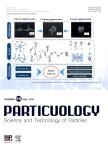Effect of nanoparticle concentration on zeta-potential measurement results and reproducibility
Effect of nanoparticle concentration on zeta-potential measurement results and reproducibility作者机构:National Physical Laboratory Hampton Road Teddington Middlesex TW11 0LW UK Department of Physics University of Bath Bath BA2 7AY UK. National Physical Laboratory Hampton Road Teddington Middlesex TW11 0LW
出 版 物:《Particuology》 (颗粒学报(英文版))
年 卷 期:2010年第8卷第3期
页 面:279-285页
核心收录:
学科分类:07[理学] 0817[工学-化学工程与技术] 070205[理学-凝聚态物理] 08[工学] 080501[工学-材料物理与化学] 0805[工学-材料科学与工程(可授工学、理学学位)] 0703[理学-化学] 0702[理学-物理学]
基 金:supported financially by the Department for Busi-ness Innovation and Skills (London UK)
主 题:Nanoparticles Zeta potential Dynamic light scattering Reproducibility
摘 要:The effect of nanoparticle concentration on zeta-potential measurement results at dilute concentrations was evaluated. The values of the zeta-potential for four different types of nanoparticles, Ludox (silica), multi-walled carbon nanotubes (bamboo-shaped and hollow nanotubes) and gold, at various concentrations, were obtained using a laser Doppler electrophoresis instrument. The size of the nanoparticles on dilution was measured using dynamic light scattering (DLS). The results show that there is a concentration range within which the zeta-potential, and particle size, are not affected by nanoparticle concentration. The lower concentration limit for the system to produce consistent results was dependent on the nature of the sample under study and ranged between 10-2 and 10-4 wt%. Below this concentration, there was an apparent shift in zeta-potential values to less negative values, which was accompanied by an increase in the particle size. The shift in zeta-potential was attributed to an increase in contribution of the signal from extraneous particulate matter. The increase in particle size was attributed to the nature of the homodyne optical configuration of the instrument. The aim of this study was to elucidate the range in nanoparticle concentration that allows for accurate and reliable measurement of the zeta-potential and DLS data.



